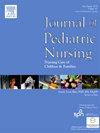Paediatric nurses' decision-making related to high flow oxygen therapy in infants with bronchiolitis: A cross-sectional survey
IF 2.1
4区 医学
Q2 NURSING
Journal of Pediatric Nursing-Nursing Care of Children & Families
Pub Date : 2025-07-03
DOI:10.1016/j.pedn.2025.06.049
引用次数: 0
Abstract
Aim
To examine nurses’ decision-making skills managing infants with bronchiolitis receiving high flow oxygen therapy in two regional Australian paediatric unit settings.
Method
A descriptive cross-sectional survey design was used to explore decision-making models in a purposive sample of paediatric nurses (target n = 88) caring for infants with bronchiolitis receiving high flow nasal cannula oxygen therapy across two regional hospital sites. Participants completed the two-part questionnaire, consisting of 1) demographic and professional characteristics and 2) the 24-item Nurse Decision-Making Instrument (NDMI). Models of decision-making were analysed overall as well as within the context of the four key phases or subscales of the NDMI.
Results
Of the 69 eligible paediatric nurses who participated in this study, the majority (80 %) used quasi-rational clinical decision-making models; indicating that both analytical and intuitive cognitive processes were employed in the decision-making process within this clinical context. Over the four phases of decision-making the quasi-rational approach continued to be predominant. Analytical decision-making was utilised slightly more in the data collection phase and steadily decreased across the phases in this sample of paediatric nurses. Casual employment status was a significant influence on the nurse decision-making instrument score, with analytical-systematic models most used in this group.
Conclusion
Infants with bronchiolitis constitute a vulnerable paediatric cohort as individuals experiencing this disease may deteriorate quickly. Ascertaining how paediatric nurses make decisions is essential for promoting optimal outcomes for this vulnerable patient cohort. While this study provides a representation of paediatric nurse decision-making models in this clinical context, further research is required to confirm these findings and inform educational opportunities which support nurses to make the best decisions based on evidence.
Implications for practice
In clinical practice paediatric nurses make numerous decisions throughout the course of a shift for this vulnerable patient cohort. Infants receiving HFNC therapy for treatment of bronchiolitis are acutely unwell and sub-optimal decision-making strategies may adversely affect patient outcomes if clinical deteriorations are not detected promptly and acted upon. It is therefore essential to ascertain how paediatric nurses make clinical decisions. This understanding will facilitate the development of quality learning resources to support effective paediatric nurses decision-making skills which will positively impact patient outcomes in a vulnerable patient cohort.
Impact
- •Study findings indicated that the majority of participating paediatric nurses used quasi-rational models in their decision-making, which comprise both analytical and intuitive approaches during cognitive decision-making processes.
- •This research contributes to nurse decision-making literature from a paediatric perspective with implications for future explorations of paediatric nurse decision-making.
- •This is the first reported study to map nurse decision-making models in a regional Australian setting utilising the Nurse Decision Making Instrument.
- •This study is the first known study to validate the Nurse Decision Making Instrument in an Australian paediatric and regional setting.
Reporting method
The checklist for Reporting of Survey Studies (CROSS) was utilised as the appropriate EQUATOR guideline for reporting.
No Patient or Public Contribution.
What does this paper contribute to the wider global clinical community?
- •Validation of the NDMI in an Australian setting.
- •Original contribution to mapping of paediatric nurse decision making models to inform effective learning resources for paediatric nurse health professionals.
儿科护士对毛细支气管炎患儿高流量氧疗决策的横断面调查
目的探讨澳大利亚两个地区儿科单位对毛细支气管炎患儿接受高流量氧治疗时护士的决策能力。方法采用描述性横断面调查设计,在两家地区医院护理接受高流量鼻插管氧疗的毛细支气管炎婴儿的儿科护士(目标n = 88)中探讨决策模型。参与者完成两部分问卷,包括1)人口统计学和专业特征,2)24项护士决策工具(NDMI)。对决策模型进行了整体分析,并在NDMI的四个关键阶段或子量表的背景下进行了分析。结果在69名符合条件的儿科护士中,大多数(80%)采用准理性临床决策模型;表明分析性和直觉性认知过程都被用于临床环境下的决策过程。在四个决策阶段中,准理性方法仍然占主导地位。在这个儿科护士样本中,分析性决策在数据收集阶段被略微更多地利用,并在各个阶段稳步下降。临时就业状况对护士决策工具得分有显著影响,本组最常用的是分析系统模型。结论毛细支气管炎患儿是一个易感的儿童群体,因为患有这种疾病的个体可能会迅速恶化。确定儿科护士如何做出决定对于促进这一弱势患者群体的最佳结果至关重要。虽然本研究提供了临床背景下儿科护士决策模型的代表,但需要进一步的研究来证实这些发现,并告知教育机会,以支持护士根据证据做出最佳决策。在临床实践中,儿科护士在整个转变过程中为这一弱势患者群体做出许多决定。接受HFNC治疗毛细支气管炎的婴儿急性不适,如果不及时发现临床恶化并采取行动,次优决策策略可能会对患者的预后产生不利影响。因此,确定儿科护士如何做出临床决定是至关重要的。这种理解将有助于开发高质量的学习资源,以支持有效的儿科护士决策技能,这将对弱势患者群体的患者结果产生积极影响。•研究结果表明,大多数参与的儿科护士在决策中使用准理性模型,其中包括认知决策过程中的分析和直觉方法。•本研究从儿科角度为护理决策文献做出了贡献,对儿科护理决策的未来探索具有重要意义。•这是利用护士决策工具在澳大利亚区域环境中绘制护士决策模型的第一个报告研究。•本研究是第一个在澳大利亚儿科和地区环境中验证护士决策工具的已知研究。报告方法调查研究报告核对表(CROSS)被用作赤道报告的适当指南。没有病人或公众捐款。这篇论文对更广泛的全球临床社区有什么贡献?•在澳大利亚设置NDMI的验证。•对绘制儿科护士决策模型的原始贡献,为儿科护士保健专业人员提供有效的学习资源。
本文章由计算机程序翻译,如有差异,请以英文原文为准。
求助全文
约1分钟内获得全文
求助全文
来源期刊

Journal of Pediatric Nursing-Nursing Care of Children & Families
NURSING-PEDIATRICS
CiteScore
3.70
自引率
8.30%
发文量
291
审稿时长
65 days
期刊介绍:
Official Journal of the Society of Pediatric Nurses and the Pediatric Endocrinology Nursing Society (PENS)
The Journal of Pediatric Nursing: Nursing Care of Children and Families (JPN) is interested in publishing evidence-based practice, quality improvement, theory, and research papers on a variety of topics from US and international authors. JPN is the official journal of the Society of Pediatric Nurses and the Pediatric Endocrinology Nursing Society. Cecily L. Betz, PhD, RN, FAAN is the Founder and Editor in Chief.
Journal content covers the life span from birth to adolescence. Submissions should be pertinent to the nursing care needs of healthy and ill infants, children, and adolescents, addressing their biopsychosocial needs. JPN also features the following regular columns for which authors may submit brief papers: Hot Topics and Technology.
 求助内容:
求助内容: 应助结果提醒方式:
应助结果提醒方式:


